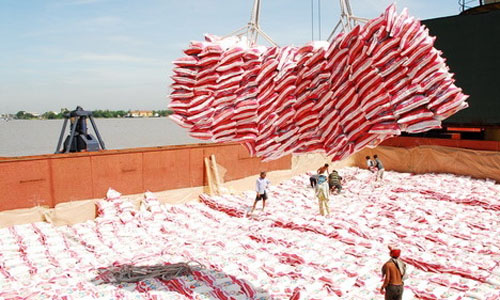Seizing opportunities for Vietnam's rice exports
ABO/NDO – The Vietnamese Government and agencies concerned have made positive moves to create a favourable and clear legal corridor and open new opportunities and markets for rice exports.
 |
| Vietnam is one of the three largest rice exporters in the world. |
According to the Ministry of Agriculture and Rural Development, the rice cultivation area accounts for around 60% of the total area of annual crops and rice production is an important source of income for roughly nine million rural households in Vietnam.
Vietnam is one of the three largest rice exporters in the world, with an annual shipment of 5-6 million tonnes to 150 countries and territories worldwide, bringing in US$2.5 billion.
However, many economic experts have stated that Vietnam’s rice exports still have many shortcomings. Despite a high export volume, the quality of rice has yet to met market demands; therefore the export value has been too low.
Under the Strategy on Vietnam Rice Export Market Development for 2017-2020, with orientation to 2030, the country will gradually improve the quality of its exported rice. The annual rice export volume will be reduced to four million tonnes per year, while the export turnover will increase US$2.3 billion – US$2.5 billion.
In order to implement the strategy, the Government issued Decree No.107/2018/ND-CP on rice export businesses and a specific strategy on the development of the rice export market, to replace Decree No.109/2010/ND-CP.
On October 11, the Ministry of Industry and Trade, in collaboration with The Rice Trader Magazine, held the 10th World Rice Conference, with the participation of representatives from hundreds of rice producers, exporters and importers from 30 countries around the world. The event demonstrated Vietnam’s important role in coordinating with its foreign counterparts.
In addition, the rice sector should provide many types of delicious rice that the markets needs instead of the existing varieties. Therefore, Vietnamese rice export enterprises need to study, build and promote the brand of high quality and aromatic rice.
It is also crucial to clarify information and market prices as well as take measures to promote the export of high quality rice to major markets. Localities should proactively plan and build high quality rice production regions and sub-regions, while applying scientific and technological advances, to serve the fastidious market and take opportunities, contributing to improving the position of Vietnamese rice in the world.
(Source: NDO)
.
 về đầu trang
về đầu trang






